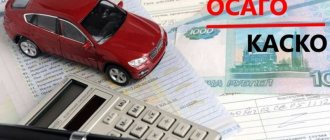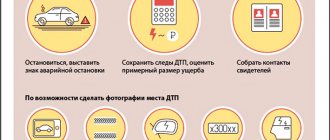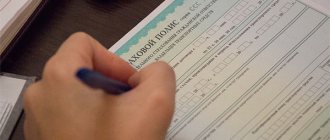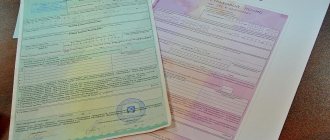July 21, 2020
The insurance company is a commercial organization, but unregulated expenses hit the wallet. Repairs under compulsory motor liability insurance do not always cover the limited payment of expenses, and insurers will try to benefit at the expense of clients. If the auto insurance does not cover the losses, the injured participant can take advantage of additional terms of the contract.
Where does the money for the surcharge come from?
During an accident, damage may occur that is not covered by insurance. The problem appears at the scene of the event or in a car service center. If compulsory motor liability insurance is correctly completed, the company is obliged to pay the remaining payment. The injured participant needs to fill out the documents correctly, if no traffic rules were violated.
When a paradoxical situation arises:
- The insurer deliberately reduces the cost of payment.
- Major repairs are more expensive than stated in the act.
The injured driver is not required to pay the costs out of pocket. They are covered by the community if a mistake was made during the preparation of the act. The commission may also be paid by the person responsible for the accident. In both cases, the victim must prove his innocence.
The company deliberately underestimates the amount
A representative of an organization can artificially reduce the cost of car insurance. When the car is repaired, the owner will be required to pay the costs. The owner of the vehicle must follow the following procedure:
- Request from the community a copy of the insurance event report. The document contains all the details of the incident. The paper is issued within three days from the date of filing the application or drawing up the agreement.
- Recheck the calculated data. There is a directory available in the public domain on the official RSA website. If the final payment does not coincide with the results of car insurance, the data is deliberately underestimated.
- Conduct an independent expert assessment. The master (organization) must be in the general register and have the appropriate certificate.
- Address the pre-trial claim to the insurer (Part 1, Article 16.1 No. 40-FZ). The administration is obliged to consider the complaint within 10 days from the date of filing. If the driver does not receive a response within this period, a claim can be filed in court. The requirement is drawn up in free form, taking into account all the circumstances.
- Filing an application to the court with the possibility of pre-trial proceedings and compensation for penalties (1% of the difference or 0.05% daily for a delay in responding to the complaint).
If the value of the claim does not exceed 1,000,000 RUB, no tax is charged. The amount of loss less than 50,000 RUB is examined by the magistrate court. If the rate is above 50,000 RUB, this is handled by district structures. The applicant is additionally entitled to half the money from the cost of damage in case of successful completion of the case.
Who pays – the insurance company of the culprit or the victim
Now let’s talk about whose insurance company pays for damages in an accident. This question interests many car owners. Today, expenses caused by an accident are paid by the insurer of the culprit. Even if the victim contacted his Investigative Committee. But not always only one company pays in full. It depends on the number of participants in the accident and the degree of guilt of each.
Mutual guilt
It is more difficult to figure out which MTPL insurance company pays for the damage if the fault of each participant in the incident is established. Both broke the rules and received the protocol. Formally, each of them is both a victim and a culprit. If both are insured, there will be no problems.
Clause 22 of Article 12 of Law No. 40 states that insurers compensate for damage caused taking into account the degree of guilt of the persons insured by them, as established by the court. If there are several culprits, the amount of compensation is established in proportion to the degree of guilt of each. In this case, the victim has the right to make claims to any insurer (if the companies are different) at will. If the degree of fault is not established, insurers compensate for damage in equal shares. At the same time, they have the right to regressive demands.
Find out in more detail how and what payments you can receive under compulsory motor liability insurance if there is mutual fault.
The culprit has not been identified
No less interesting is the question of who pays for compulsory motor liability insurance if the culprit of the accident is not identified. Let's say he escaped, they are looking for him, but so far in vain. What to do? The problem is that, according to the terms of the contract, there must be a culprit, otherwise the insurance agreement is not fulfilled by the insurance company in terms of payments (according to paragraph 1 of Article 18 of Law No. 40-FZ). Then you need to contact the RSA, as in the case when the culprit does not have a compulsory motor liability insurance policy.
The culprit and the victim have the same insurance code
When both drivers are insured by the same company, there should be no questions. In any case, one organization pays for the repair of the car.
Repairs cost more than insurance
If the price of special repairs exceeds the specified amount of insurance, the victim can take advantage of Article 1064 of the Civil Code, Part 1. The difference will be paid by the delinquent.
The actions should be as follows:
- Conduct an autonomous peer review.
- Send a pre-trial request to the delinquent. The claim must indicate the missing amount.
- If the responsible participant refuses to pay the costs, send a statement to the court.
The procedure allows the situation to be resolved peacefully. Problems arise if the responsible party refuses to pay. Only through the court can the issue be resolved.
What is needed to collect the missing amount?
Amendments to the OSAGO law oblige repairmen to use new and high-quality parts. Replacement and repair of damaged components occurs in accordance with established standards. The rules do not specify the manufacturer, but if the vehicle is less than two years old, it must be sent to an authorized service center.
During the period of filing a claim, the motorist must have an insurance contract and an independent examination report. If the case goes to justice, you must add:
- photocopy of passport;
- power of attorney for the right to own a car (PTS, STS);
- certificate of accident;
- OSAGO certificate;
- a photocopy of the pre-trial claim and the response of the other party (the insurer or the culprit of the incident);
- video/audio evidence and witness statements;
- expense receipt.
Events may vary. The car owner needs to collect documentation in advance (after the accident) in order to have a strong argument. A missing transcript or receipt could jeopardize the prosecution's trial.
Who pays in case of an accident?
If we consider this issue from the point of view of common sense, it becomes obvious that the driver (or other road user) who is responsible for this event must pay for the results of an accident.
Approximately the same thing is enshrined in Russian legislation, namely in the civil code of the Russian Federation.
First, let's look at Article 1079, which is called “liability for harm caused by activities that create an increased danger to others” and applies specifically to cars and road accidents:
Article 1079. Liability for harm caused by activities that create an increased danger to others
1. Legal entities and citizens whose activities are associated with increased danger to others ( use of vehicles , mechanisms, high-voltage electrical energy, nuclear energy, explosives, potent poisons, etc.; carrying out construction and other related activities etc.), are obliged to compensate for damage caused by a source of increased danger, unless they prove that the damage arose as a result of force majeure or the intent of the victim. The owner of a source of increased danger may be released by the court from liability in whole or in part also on the grounds provided for in paragraphs 2 and 3 of Article 1083 of this Code.
The obligation to compensate for damage is assigned to a legal entity or citizen who owns a source of increased danger on the right of ownership, the right of economic management or the right of operational management or on another legal basis (by lease, by power of attorney for the right to drive a vehicle, by virtue of an order of the relevant body on transferring to him a source of increased danger, etc.).
So, having read in detail the text of the first part of Article 1079, we can conclude that in the event of a collision between two cars, each of their drivers (i.e. the owner, or the person driving the car on a rental basis, or the person driving the car by proxy) must compensate for the damage caused by a car.
In our case with an accident, this can be considered as follows: each of the car owners pays for the repair of someone else’s car .
However, in practice, both drivers do not always pay each other for repairs, and this fully corresponds to common sense. After all, both drivers are not always to blame for an accident (both drivers do not always violate traffic rules). Quite often, only one driver is at fault, and it is he who must pay for the repair of someone else’s car.
This can be judged on the basis of Article 1083 of the Civil Code:
Article 1083. Taking into account the guilt of the victim and the property status of the person who caused the harm
2. If the gross negligence of the victim himself contributed to the occurrence or increase of harm, depending on the degree of guilt of the victim and the causer of harm, the amount of compensation should be reduced.
In case of gross negligence of the victim and the absence of guilt of the harm-doer in cases where his liability occurs regardless of guilt, the amount of compensation should be reduced or compensation for harm may be refused, unless otherwise provided by law. If harm is caused to the life or health of a citizen, refusal to compensate for the harm is not allowed.
Those. a driver who drove calmly along the road, did not hurt anyone and, most importantly, did not violate traffic rules, should not have to pay for repairs to a car whose driver is at fault for the accident.
But the driver at fault for the accident must pay for the repairs in full. In practice, repairs are usually paid for using a compulsory motor third party liability insurance policy (MTPL), but insurance is not the topic of this article, so we will not dwell on it in detail.
As for the repair of the car of the culprit himself, he must pay for it himself at his own request and only from his own pocket.
Rights and obligations of the parties
If the contract is not signed, and the company or service station demands money, you should not pay it. The difference in payment is the relationship between the auto insurer and the client, but not the service center. Any threats, blackmail and attempts to evade responsibility are resolved through the justice system.
By law, you have 30 days to repair your car. If the vehicle is not returned during this period, the owner can write an appeal to the prosecutor's office. Car insurers have no reason to force compensation. For everything to go legally, the driver needs to take into account all the nuances:
- conduct an independent assessment of damaged vehicles;
- refuse to sign additional papers;
- consult with a legal entity;
- monitor changes in regulations.
If the auto insurer managed to get the client to sign questionable papers, the outcome depends on the complexity and timing of the process. You can try to increase the amount of accrual through an independent examination and make claims to the service station. When signing a dubious contract, the applicant is unlikely to be able to resolve the issue in his favor.
After a collision, the injured party has the right to demand full compensation for damage. The policy does not always cover the damages caused, and the agent can take advantage of the car owner's naivety by covering the shortfall from his pocket.
If the vehicle owner completes the documentation correctly, the organization will cover the shortfall and transfer the vehicle to a service center, where employees will have to replace the damaged parts with new spare parts within a specified period of time.
Accident with three unknown persons
So, a certain Semenov gave his car to a certain Maksimov. Maksimov crashed it into the car of a certain Malashchinsky standing at a traffic light. The traffic police officers registered the incident, admitting that Maksimov was to blame. It turned out that Maksimov was not included in the OSAGO policy. That is, his civil liability is not insured. He also refused to voluntarily compensate for the damage.
Malashchinsky had to conduct an independent assessment of the damage and file a lawsuit against Maksimov in court. But then a problem arose: the plaintiff decided to change the defendant. According to the portal Pravo.ru, at a meeting on his case of the Supreme Court, when asked by the judge why he did this, Malashchinsky replied: “At first I didn’t know who the owner was. When at the first court hearing it turned out that Maksimov was not the owner, the judge told me: “Just think about it, you must choose the right defendant.” And we decided to change the defendant.”
As a result, the trial judge rejected the claim. He indicated that the person responsible for the collision should compensate for the damage. Semyonov entrusted him with the car along with the keys and documents. Consequently, at the time of the accident, Maksimov legally owned the car and therefore he should be responsible for the damage.
The Court of Appeal overturned this decision and partially satisfied the claims of the victim in the accident. He came to the conclusion that Semenov was the owner of the car at the time of the accident. Maksimov was not given a power of attorney to drive the vehicle, and no lease agreement or other order was presented. Accordingly, the owner of the source of increased danger and, therefore, the person obliged to compensate for the damage is the owner.
But the cassation court did not agree with this decision. He recalled that since 2012, the driver’s obligation to carry a power of attorney was abolished. Semenov could transfer the car to Maksimov for use without issuing a power of attorney. In addition, Maksimov himself, brought in as a third party, did not object that he was the owner of the car at the time of the accident and it was he who should compensate for the damage. Therefore, the court of cassation overturned the appeal decision, leaving the decision of the first instance court in force.
However, the Supreme Court did not agree with such conclusions. He overturned the decision of the court of cassation, remanding the case for a new trial. The reasoning for the decision has not yet been published, so it is difficult to say on what grounds he did this. But, given that his position on this issue has not changed for several years, we can recall similar cases.
For example, a case where the driver used the car by proxy, but was not included in the insurance. The courts of the first and appellate instances considered that it was he who should compensate for the damage. However, the Supreme Court indicated that the act of transferring the right to drive it by the owner of a car to another person, including the transfer of keys and registration documents for the car, only confirms the will of the owner to transfer this property for use. It does not indicate a transfer of ownership of the property. Such use does not deprive the owner of the property of the right to own it, and, therefore, does not relieve him of the obligation to compensate for damage caused by this source of increased danger.
The courts must establish the degree of guilt of both the driver and the owner of the car. This is the basis for the distribution of the share of compensation for harm
In addition, in similar cases, the Supreme Court indicates that lower courts must establish the degree of guilt of both the driver and the owner of the car. This is the basis for the distribution of the share of compensation for harm.
As lawyer Lev Voropaev explained to RG, the Supreme Court of the Russian Federation has for a long time proceeded from the fact that if the liability of the driver who is at fault for the accident was not insured under compulsory motor liability insurance at the time of the accident, then liability for damages is also assigned to to the owner of the vehicle. In this case, the victim had to file a claim immediately against both the owner and the driver. Then you wouldn’t have to go through so many instances to obtain compensation for damage.











